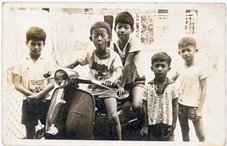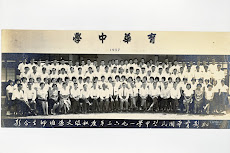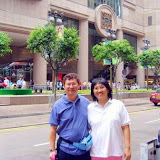Er Hu Chinese Violin, Chan Kum Loong
I visited a friend in Shah Alam and he invited us for dinner and mentioned that his Er Hu teacher (Mr. Chan Kum Loong) will be joining us and after that maybe play us a song or two. After a casual introduction we found out that he once taught Er Hu in SMJK Yu Hua Kajang. He spoke passionately about music and his Er Hu, we finished dinner and proceeded back to my friend house. He insisted that before he play his Er Hu he would like to hear KC sing a song which she obliged with a chinese number by Teresa Teng. And I requested that he allowed me to video him playing his Er Hu. Ah Loong as he is known, sometimes get invited along with some of his friends to perform usually for dinner functions such as birthday and etc.
I did a search on the internet and I found out that Er Hu has over a thousand year history. Er Hu is a kind of violin (fiddle) with two strings which, together with zhonghu, gaohu, sihu, etc, belongs to the "huqin" family. It is said that its origin dated back to the Tang dynasty (618-907) and related to the instrument, called xiqin originated from a Mongolian tribe Xi. During Song dynasty (960-1279), the second generation of the huqin was among the instruments played at the imperial banquets. During the Dynasties of Ming (1368-1644) and Qing (1644-1911), the Er Hu underwent a great development at the time of the golden age of the local operas. The Er Hu then developed into different "schools". Two famous artists Hua Yanjun (1893-1950) and Liu Tianhua (1895-1932) made an exceptional contribution to the improvement of the Er Hu, and it was indeed due to the latter that the erhu, an instrument mainly for accompaniment in an opera, became a solo instrument. After the formation of the People's Republic of China (1949), the production of the Er Hu, the playing techniques, the repertoire as well as the musical education of this instrument have undergone an unpresidented development. The repertoire has grown rapidly in the genres of solo, with ensemble as well as concerti with symphony orchestra. Er Hu now has become one of the most popular instruments in China.
Teresa Teng Song
The sound body of the Er Hu is a drum-like little case usually made of ebony or sandalwood and snake skins. It usually has a hexagonal shape with the length of approximately 13 cm. The front opening is covered with skin of python (snake) and that of the back is left open. The functions of this case of resonance are to amplify the vibrations of the strings. The neck of the Er Hu is about 81 cm long and is manufactured with the same materials as the drum. The top of the stem is bent for decoration. The two strings of the Er Hu is usually tuned D and A. The two tuning handles (pegs) are found close to the end of the stem. There is no frets (as contrast to the lute) or touching board (as contrast to violin). The player creates different pitches by touching the strings at various positions along the neck of the instrument. The strings are usually made of silk or nylon. Nowadays, metal strings are commonly used. The bow is 76 cm long and is manufactured of reed which one curves during cooking and arched with horse hair in the same way as the bow of violin. However, in the case of Er Hu, the horse's hair runs between the two strings. One cannot take off the bow from the instrument unless one of the two strings is taken off or broken. (the above is extracted from www.philmultic.com)
I was amazed with the song played on the Er Hu and it felt as if some part of my body move along with the rhythm, well if you have the opportunity to listen live you will understand what I mean.
Teresa Teng Song

















